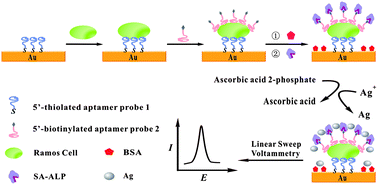Aptamer-aided target capturing with biocatalytic metal deposition: an electrochemical platform for sensitive detection of cancer cells
Abstract
A novel aptamer biosensor for cancer cell assay has been reported on the basis of ultrasensitive

* Corresponding authors
a
State Key Laboratory of Chemo/Bio-Sensing and Chemometrics, College of Chemistry and Chemical Engineering, Hunan University, Changsha, P. R. China
E-mail:
tanglijuan@hnu.edu.cn, xiachu@hnu.edu.cn
Fax: +86-731-88821916
Tel: +86-731-88821916
A novel aptamer biosensor for cancer cell assay has been reported on the basis of ultrasensitive

 Please wait while we load your content...
Something went wrong. Try again?
Please wait while we load your content...
Something went wrong. Try again?
Z. Yi, X. Li, Q. Gao, L. Tang and X. Chu, Analyst, 2013, 138, 2032 DOI: 10.1039/C3AN36474G
To request permission to reproduce material from this article, please go to the Copyright Clearance Center request page.
If you are an author contributing to an RSC publication, you do not need to request permission provided correct acknowledgement is given.
If you are the author of this article, you do not need to request permission to reproduce figures and diagrams provided correct acknowledgement is given. If you want to reproduce the whole article in a third-party publication (excluding your thesis/dissertation for which permission is not required) please go to the Copyright Clearance Center request page.
Read more about how to correctly acknowledge RSC content.
 Fetching data from CrossRef.
Fetching data from CrossRef.
This may take some time to load.
Loading related content
